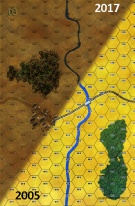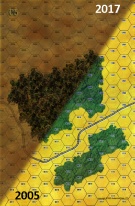|
Neva River Crossing Sinister Forces #24 |
||
|---|---|---|
| (Defender) Germany | vs | Soviet Union (Attacker) |
| Formations Involved | ||
|---|---|---|
| Germany |  |
4th SS "Police" Division |
| Soviet Union |  |
268th Rifle Division |

|
| Overall Rating, 1 vote |
|---|
|
3
|
| Scenario Rank: --- of 964 |
| Parent Game | Sinister Forces |
|---|---|
| Historicity | Historical |
| Date | 1941-08-19 |
| Start Time | 09:00 |
| Turn Count | 15 |
| Visibility | Day |
| Counters | 124 |
| Net Morale | 0 |
| Net Initiative | 1 |
| Maps | 2: 3, 6 |
| Layout Dimensions | 56 x 43 cm 22 x 17 in |
| Play Bounty | 137 |
| AAR Bounty | 167 |
| Total Plays | 1 |
| Total AARs | 1 |
| Battle Types |
|---|
| River Crossing |
| Conditions |
|---|
| Off-board Artillery |
| Reinforcements |
| Scenario Requirements & Playability | |
|---|---|
| Beyond Normandy | Counters |
| Eastern Front | Maps + Counters |
| Sinister Forces | Base Game |
| Introduction |
|---|
|
The Soviets began to worry that the fall rains would halt Russian offensives with the Germans still too close to Leningrad. In order to prevent this, the experienced and professional 268th Rifle Division was tasked with crossing the Neva River, establishing a bridgehead there and expanding it to the east. On the other side of the river waited the men of the Police Division. |
| Conclusion |
|---|
|
The Soviets successfully established a bridgehead over the Neva River, but prompt German response from the Police Division stopped the eastward expansion. Over the next days the two divisions engaged in intensive combat, with the Germans slowly gaining the upper hand. Finally admitting that their efforts were doing nothing but running up casualties, the Soviets called of the offensive. |
| AFV Rules Pertaining to this Scenario's Order of Battle |
|---|
|
| 3 Errata Items | |
|---|---|

|
All SS 75mm IG guns are direct fire weapons (black), not indirect (white). (Shad
on 2010 Dec 15)
|

|
The reduced direct fire value in Kursk: Burning Tigers is 4-4. (plloyd1010
on 2015 Jul 31)
|

|
Kommissars never get morale or combat modifiers. Ignore misprints. (Shad
on 2010 Dec 15)
|
| 200 Meters at a Time | ||||||||||||
|---|---|---|---|---|---|---|---|---|---|---|---|---|
Played solo in 8.5 hours. As I had not played any solo scenario for the past month due to an eye problem, I was looking forward to a medium size scenario I could finish in a weekend. I selected this specific scenario because it had no recorded play, very little leadership, and unusual victory conditions. The Soviets win if they have 20 or more non-demoralized steps east of the river at the end of the game; the Germans win if the Soviets have less than 20 non-demoralized steps east of the river and the Germans have the majority of the Soviets in their sights and within shooting distance. Everything else is a draw. Crossing the river will be a hard task because there is only one bridge and the two Soviet engineers will have to survive the powerful German OBA (2 x 16, 1 x 24) if they get anywhere close to the river. I set up the Germans in small 3 to 4-unit groups along the river with a much larger concentration of troops near the bridge. The mortars were set in the wood closest to the bridge, out of sight of any advancing Soviet troops. I believe it was a mistake to set the mortars so close to the front; although it allowed them to shell troops on the far side, it made it too easy for the Soviets to silence them once they had enough troops across the river. I split the Soviets into three groups. Two small groups, each with 9 foot units and an engineer, are to try to cross the river at his northern and southern points. The units with bombardment factors are to stay out of line of sight and the rest of the troops are to force their way across the bridge. The center sees combat almost immediately (2nd turn); the KV-1s raced up the road to discourage German units from trying to dig in on the bridge. The Germans respond with 37mm crossfire but miss, a story that was repeated for the next 3½ hours. The north and flanking groups move towards the river. The Germans bombard he group to the south and after 30 minutes, half the Soviets in that group alrea disrupted or demoralized. Not a good start for the Soviets. The center group moves next to the river on the third turn and loses 2 steps, a small price to pay for such a quick advance. They fire en masse the following turn and eliminate a German INF platoon and reduce another. A Soviet Lieutenant, sensing an opportunity, leads several platoons across on bridge and then sends the troops into assault. Soviets casualties are high, 13 steps by turn 6, but they are making progress. The Germans reinforce the assaults to try to push back the Soviets back but that leaves them with very little reserve. The Soviets win an assault and start another assault 200m further away from the river. By the end of turn 8, the Soviets have 15 undemoralized east of the river but they need more space if more are to come across. The Soviets move a KV-1 east of the river and the Germans decide it is unacceptable. The 88mm fires but misses. A Soviet captain sees the flash and calls in artillery which, to his surprise, immediately eliminates the 88mm. The Germans try a crossfire shot from the 50mm and miss again. The same captain directs the 76.2mm to fire at the 50mm and it’s another perfectly placed fire mission. With the elimination of the Germans two most potent AT guns, the remaining KV-1 cross the bridge but travel a bit too far as it leaves an opportunity for the Germans to seal off the bridge. The next three turns (12, 13, and 14) see the Soviets breaking the seal and the result is no longer in doubt. Soviet victory! I gave this one a “3” but would have given it a “4” if it played quicker. It’s a technical scenario in the sense you need to calculate the order of your Soviet activations at the beginning of the turn if they are to make progress. It’s something I enjoy but it might be annoying to players who enjoy a faster pace. I did learn some lessons. 1. Crossing a river against a defender who has a powerful OBA is a hard task. I will use even less defenders on the flanks and rely on the OBA to prevent those crossings. 2. It may be better for the defenders to take the fight to the attackers on the bridge. The defenders will have a higher casualty rate but that will create a single hex choke point which will require clearing. |
||||||||||||
| 0 Comments |

 SiFo023
SiFo023 





























